Wizards of the Coast has announced its latest Secret Lair drop, Black is Magic, to celebrate Black History Month. The drop features seven full art, borderless cards illustrated by Black artists and will be available from February 22 to March 31 for either $39.99 (non-foil) or $49.99 (foil). All proceeds from the drop will benefit Black Girls CODE.
“The Black Is Magic drop celebrates and supports different expressions of Black identity,” Wizards said. “Each card was illustrated by a Black artist who brought their unique art style to the drop. Ernanda Souza interprets Shalai, Voice of Plenty as a guardian angel who protects and shields the people.”
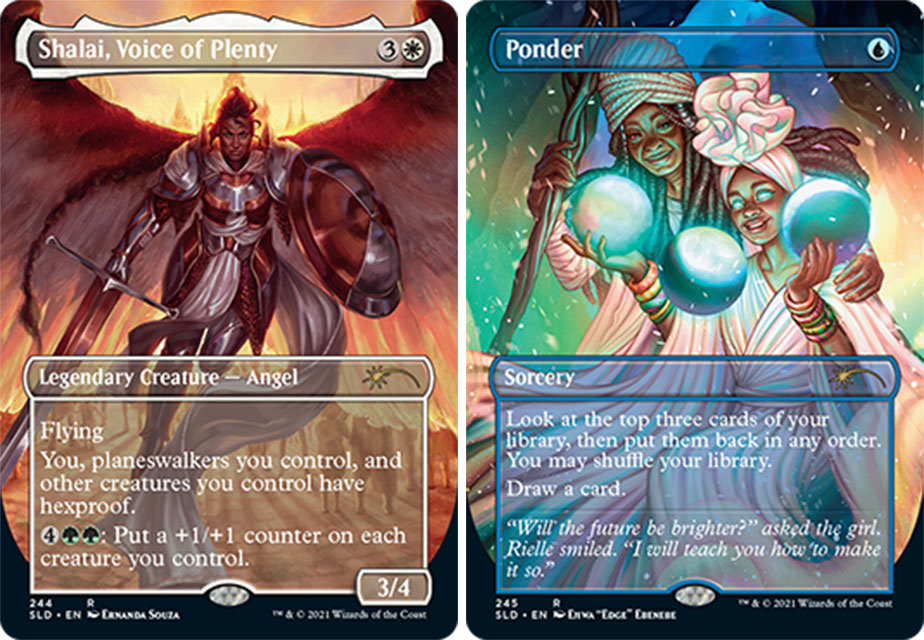
The second card revealed today was Ponder by Ejiwa “Edge” Ebenebe, which “honors elders and African spiritual tradition,” Wizards said.
The other five cards are illustrated by Hillary Wilson, Dani Pendergast, KNIIO, Thomas Zenteno, and Julio Reyna and will “celebrate more aspects of the Black experience” to be revealed on February 9 and 16. Of the seven featured artists, only Dani Pendergast has previously illustrated a Magic card—Arcane Signet from the A Box of Rocks Secret Lair.
UPDATE (2/9/2021): Three more cards have been revealed: Cultivate, Kaya, Ghost Assassin, and Teferi, Hero of Dominaria.
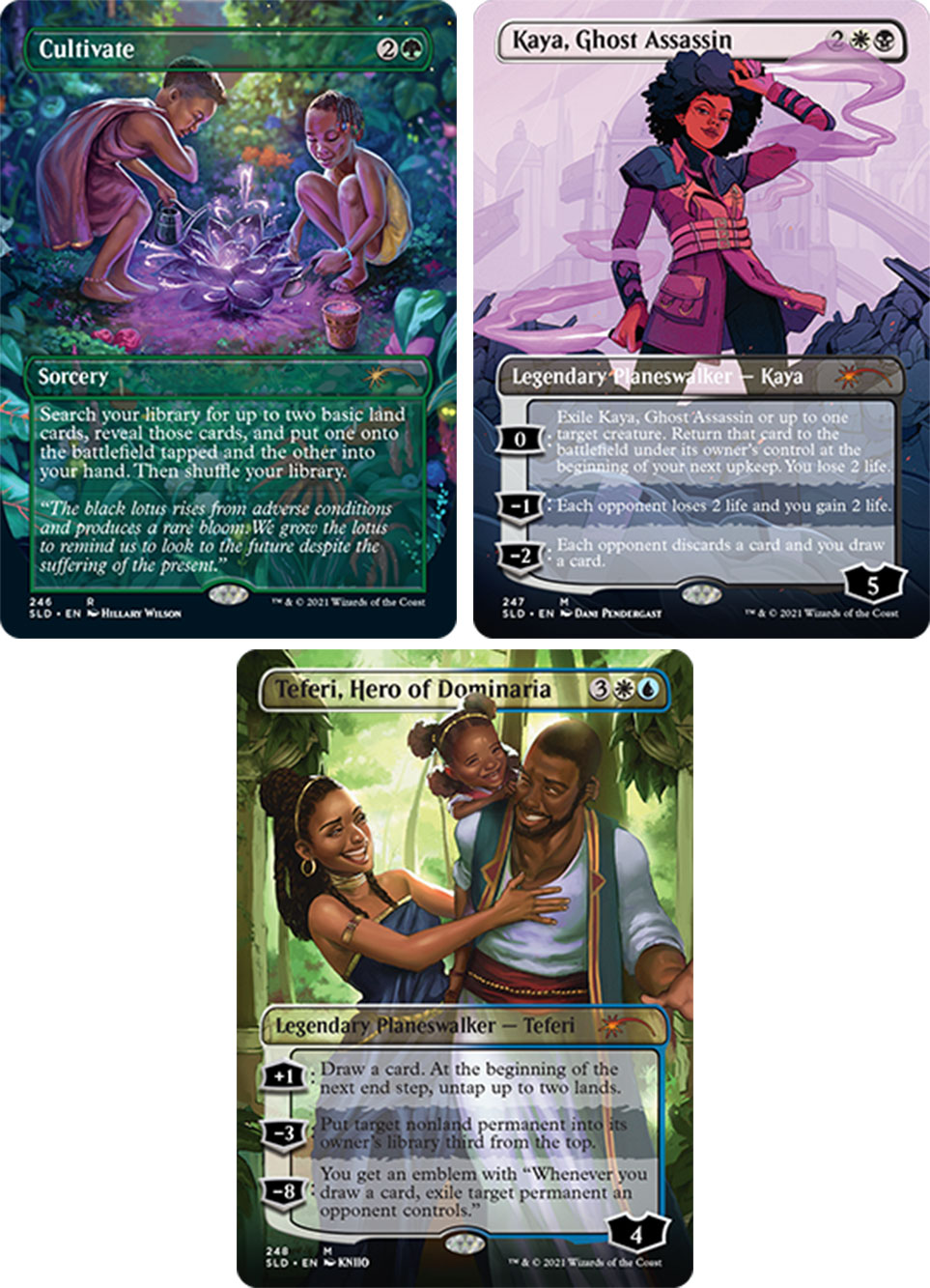
UPDATE (2/16/2021): The final two cards have been revealed: Sol Ring, and Path of Ancestry.
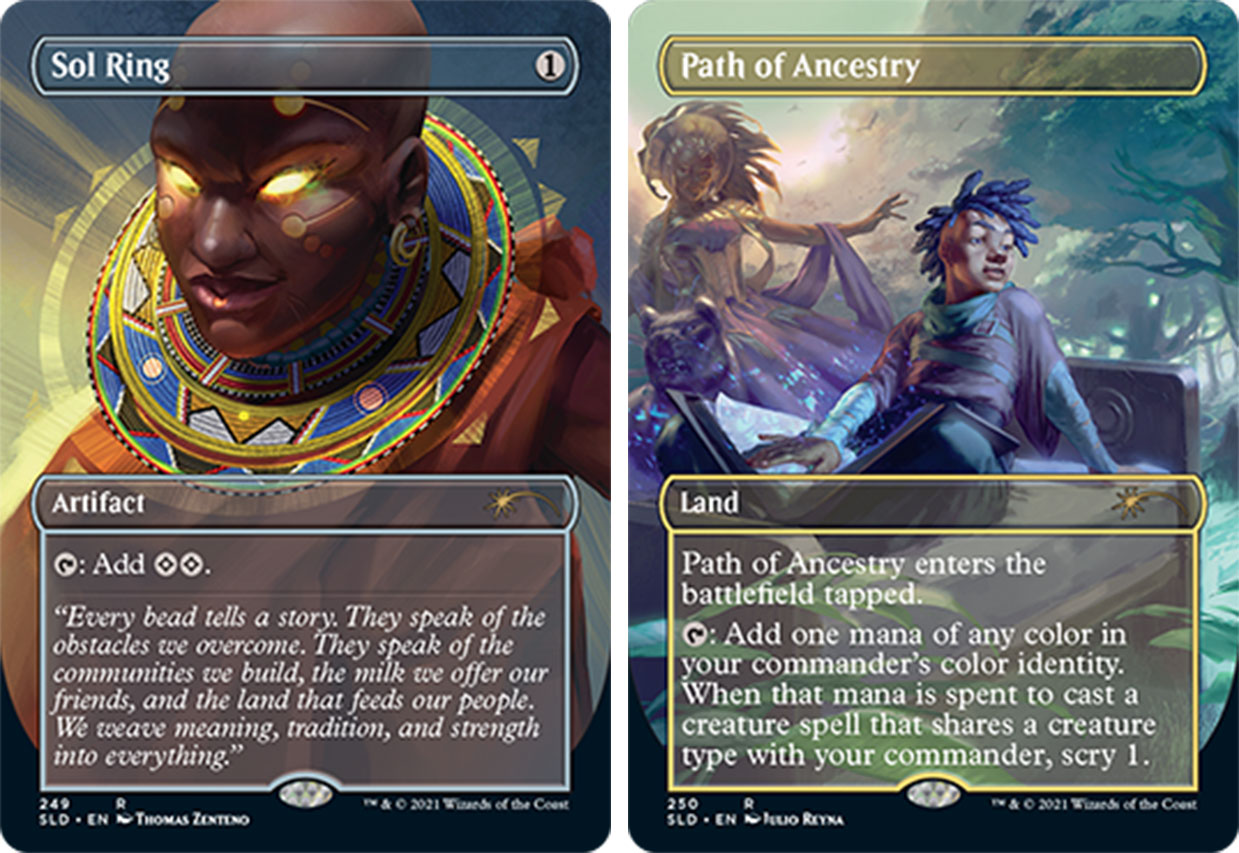
“Black is Magic seeks to honor Blackness in its beautiful, global entirety, and to celebrate Black history and culture in both Magic: the Gathering and the real world,” said Sydney Adams, the creative lead for the Black Is Magic. “My hope is that this drop says one thing to Black and Black Magic: the Gathering communities — ‘My community.’ You are here, you have always been here, you always will be here, and we will fight for you to be here. In our history. In our culture. And in our games.”
Shalai, Voice of Plenty
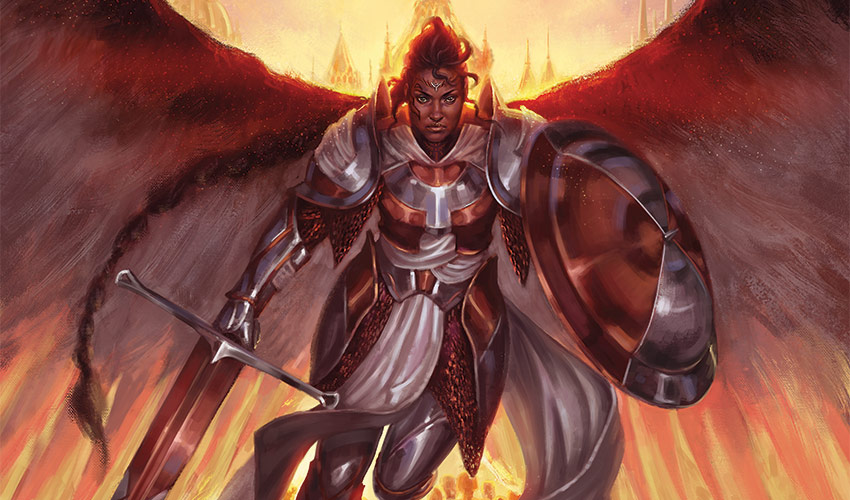
Shalai, Voice of Plenty by Ernanda Souza
“Shalai is the only Serra Angel of African descent though her art in the past has been racially ambiguous,” Adams explained.
“When concepting this card, I thought about who Shalai was at her core,” she continued. “I thought about why she chose to protect the Llannowar elves in the Phyrexian invasion, her most notable achievement. Then I realized, of course she would. In human-dominated Dominaria, Llanowar elves are in some ways, a marginalized group.”
“Many of the angel figurines cover children with their wings, a visual sign of their protection,” Adams said, and Ernanda Souza illustrated Shalai with her wings spread so wide that they occupy the entire frame. “If you look under her wings, you’ll see the silhouette of a small child on either side holding the hand of their parent,” she revealed.
Ponder
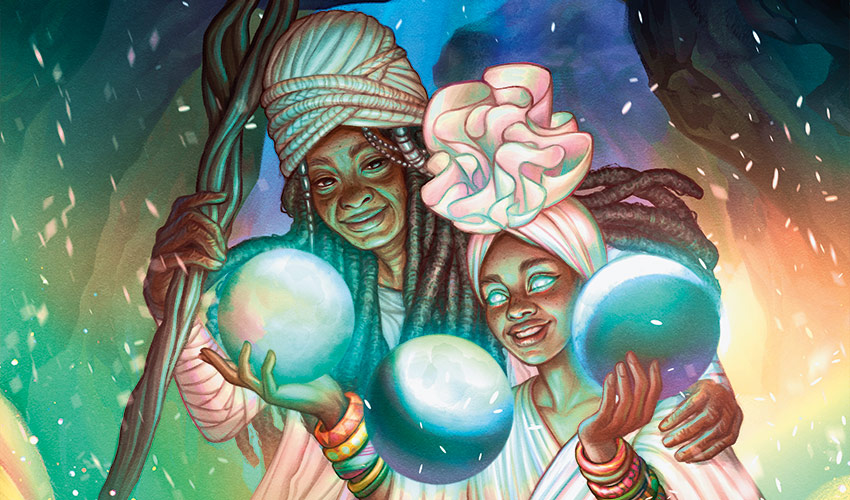
Ponder by Ejiwa “Edge” Ebenebe.
“In modern times, there has been a rise in young Black Americans seeking out these lost traditions as a grounding way to heal and build community,” Adams said. “I wanted this card to be a nod to this transition. It shows an elder, most notably our new Ikoria commander, Rielle, the Everwise, guiding a young seer.”
“Ejiwa ‘Edge’ Ebenebe did such a beautiful and realistic portrayal of how older Black women support younger ones,” she continued, “and the eagerness the younger generation has for seeking a connection with what they have lost, not to mourn, but to build a better future for themselves.”
Cultivate
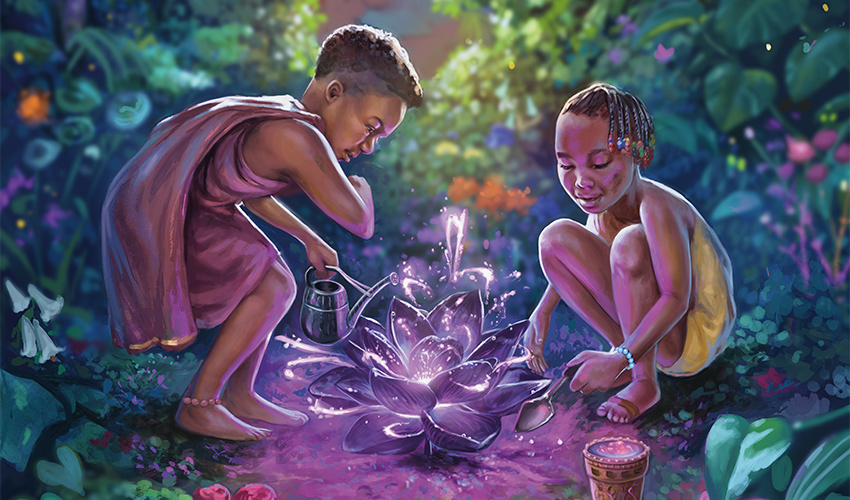
Cultivate by Hillary Wilson.
“When I concepted this card, I thought about what it means to cultivate land in this narrative,” Adams said. “My puny ‘struggle-bubble’ balcony garden, community plots to support neighborhoods that are food deserts, and the larger narrative of farming as a whole. This card has a lot to say, and without an article, it would be impossible to say it all. In short, it is my way of affirming the validity of Black farming and highlights ways in which growing things connects future generations to their roots.”
“We see two beautiful Black children growing the Black Lotus, the most iconic and powerful symbol in Magic’s history,” she continued. “These little Black kids are not just in possession of such a powerful item, they are the ones cultivating it. They are the ones who make the Black Lotus bloom. A lotus, growing in the mud, symbolic of overcoming adversity in so many cultures. Hillary Wilson skillfully rendered this gorgeous imagery, and we can feel the magic in every corner we gaze on.”
Kaya, Ghost Assassin
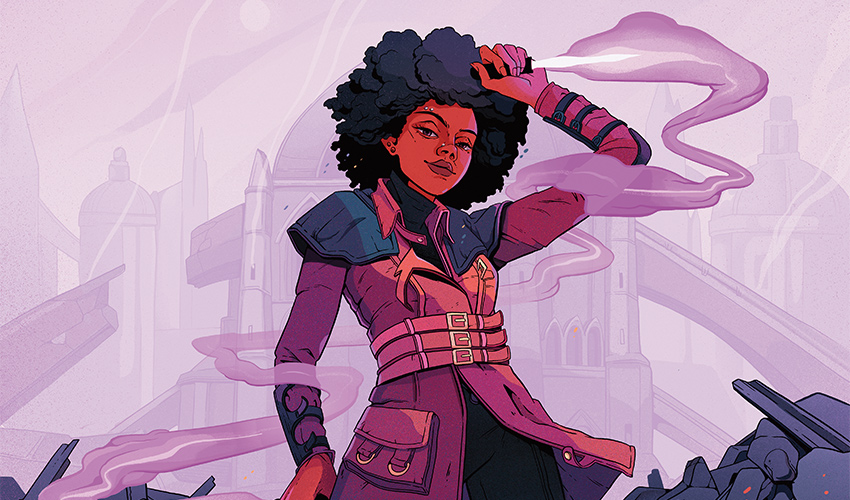
Kaya, Ghost Assassin by Dani Pendergast.
“Kaya is the reason I know Magic,” Adams revealed. “A couple years back, I saw her leaning against a door with her sculpted cheekbones, and I was intrigued. I looked her up, found Magic: The Gathering, and the rest is history. She is proof that representation matters, and Dani Pendergast gave us this phenomenal version of her.”
“Kaya’s afro is one of her most iconic features and a multigenerational symbol of Black power and pride,” she continued. “I told Dani I wanted it to remind me of Diana Ross, the diva of divas. Here’s to the Black female trailblazers that change our lives and all the people supporting them.”
Teferi, Hero of Dominaria
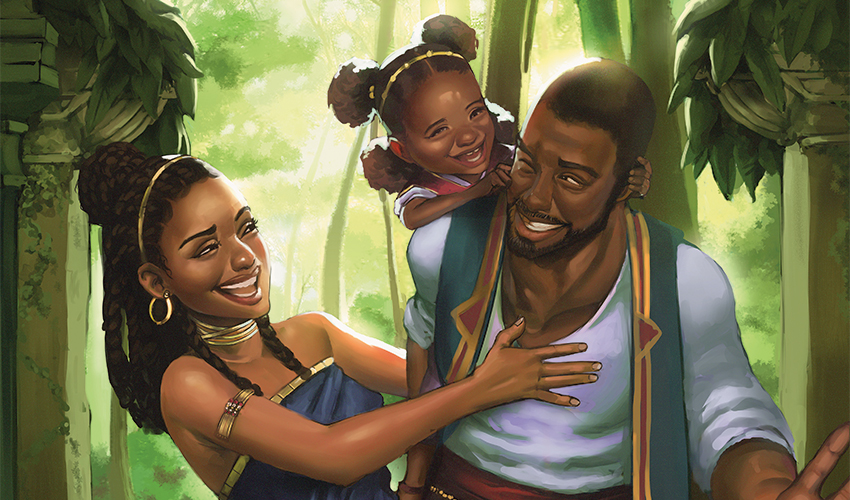
Teferi, Hero of Dominaria by KNIIO.
“This card is my love letter to Black fatherhood and family, and I think honoring Magic’s favorite Time Dad is the perfect way to do it,” Adams said. “Teferi is the first Black Planeswalker in Magic’s history and has some of the most impactful cards and richest backstories in our lore. Before he was a wise authority figure, he was a student of Urza and a notorious prankster.”
“My favorite part of Teferi’s story occurs after he has lost his spark and is wandering around Dominaria,” she revealed. “He is broken down emotionally, a villain to most who know of him, and looks young, but has lived several lifetimes. By chance, he ends up framed in a murder plot involving a caravan of modern-day Zhalfirins. These travelers are undesirables, regarded with suspicion and offered no help, and he empathizes as an outcast himself. There, Teferi meets his future wife, Subira—the caravan leader, and a powerful figure in her own right.”
“This card is what I imagine it would have been like during those years that Teferi healed from his trauma and learned to live again, bolstered by Niambi and Subira’s love. So much is known about the Time Mage Teferi, but the women who made him are sometimes absent. Subira made her first visual appearance in our game in Core Set 2021, and now that we know what she looks like, I wanted to complete the family. KNIIO managed to convey the love and nurturing between them in such a small space. Every time I look at it, I think of my parents, and I can see myself and my family in his family.”
Sol Ring
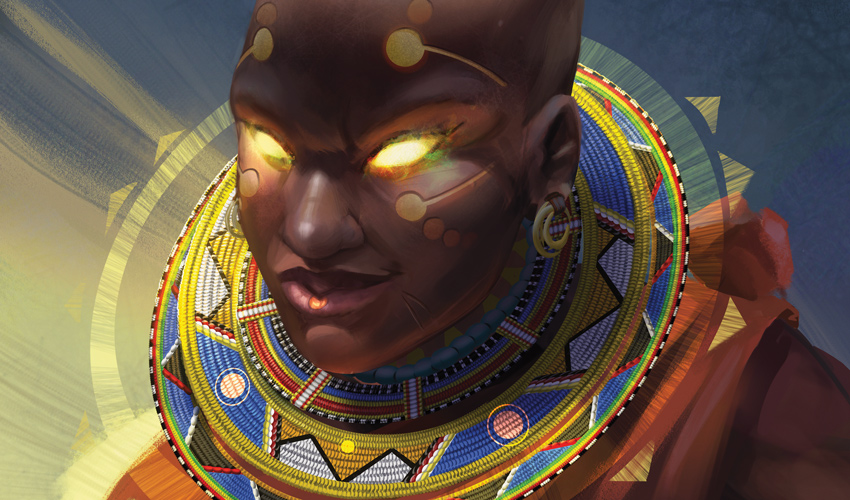
Sol Ring by Thomas Zenteno
“When concepting this card, I was inspired by the jewelry from the Maasai tribe,” Adams revealed. “I remembered seeing one of their gorgeous necklaces in a documentary, and as I did my research, I learned more about the Maasai Wilderness Conservation trust and some of the struggles they currently face.”
Kenya recognizes over fifty tribes of native people. The Maasai were the dominating tribe at the beginning of the 20th century. They are one of the very few tribes who have retained most of their traditions, lifestyle, and lore. The Maasai have not fared well in modern Africa. Until the European settlers arrived, fierce Maasai tribes occupied the most fertile lands. The Maasai struggled to preserve their territory, but their spears were no match for armed British troops, and their lawyers never had a fair chance in British courtrooms. In 1904, the Maasai signed a first agreement, losing the best of their land to the European settlers . . . Less land for an ever-growing Kenyan population means less land for the Maasai, their livestock, and wildlife.
– Maasai Wilderness Conservation Trust
“The art Thomas Zenteno provided is a Magic interpretation that imbues the user with power and light,” she continued. “It is not only my hope to show how beautiful and meaningful Maasai jewelry is but also to bring attention to the tribe and their conservation efforts.”
The card’s flavor text—which begins with, “Every bead tells a story”—is a direct reference to the role of the necklaces in Massai culture. “One of the reasons that Maasai jewelry is so special is that every bead has meaning,” Adams explained. “Women and men in these tribes wear these beaded pieces for many reasons, some as a symbol of their health, wealth, marital status, number of children, and more. These pieces, each unique and unlike any other, have cultural power within the tribe.”
Path of Ancestry
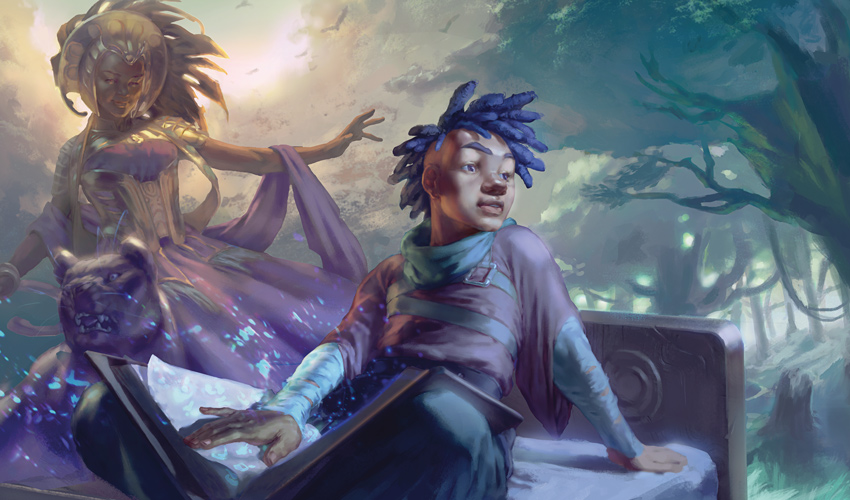
Path of Ancestry by Julio Reyna
“With this final card, I wanted to pay homage to one of the ancestors of Magic’s Black history, Jolrael, Empress of Beasts,” Adams said. “Jolrael was one of the oldest surviving Zhalfirins, a powerful and influential court mage for the capital, and a dear friend of Teferi.”
“Jolrael was able to command the respect of powerful beasts and creatures long before Vivien Reid,” she continued. “She was the strong Black female legend before Kaya. She was a friend to Teferi before he was a Planeswalker. Jolrael is the ancestor of so many amazing characters we know and love. She paved the path.”
This path paved, or trail blazed, is what connects Jolrael (who stands in the background of the image) to the new art for Path of Ancestry. “What is a path of ancestry?” Adams asked. “I interpret Path of Ancestry to mean following the road your ancestor has broken in for you. It is honoring those who came before us, those who lived through so much and still taught us how to be resilient and bear witness to the births, deaths, and rebirths of our hopes for equality. It is every generation’s dream to walk further in their name. Fantasy setting, or real life.”
“Imagine a little Zhalfirin boy reading about Jolrael in his history book and being inspired to explore more of the natural world. To lead conservation efforts, to master magic and learn to speak with animals. Can you see it? The power of her example, the truth in her story transporting him from his bedroom into the jungles of Mwonvuli. And somewhere, in the space between spaces, Jolrael watches over him, and she smiles.”

